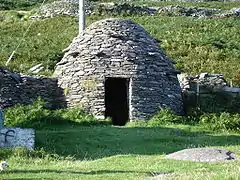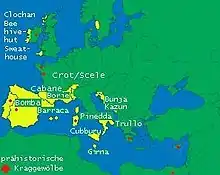Dry stone hut
Types of dry stone hut include:
- Clochán, associated with the south-western Irish seaboard
- Mitato, found in Greece, especially on the mountains of Crete
- Orri, associated with Ariège, France
- Shielings in Scotland
- Trulli, in Apulia, Italy

A clochán on Dingle Peninsula, Kerry, Ireland
Uses of dry-stone huts include temporary shelter for shepherds and their animals, permanent habitations for monks or agricultural workers,[1] storage and cheese making. Dry-stone huts may be thatched or roofed with sod, sometimes bound together with plant roots such as those of Madonna lily or sedum.[2]

Distribution in Europe
References
- Roger Sénat, Gérard Canou, Caselles du Quercy, Éditions du Laquet, Martel, 2001, 192 p., en part. chap. Les besoins des hommes, pp. 47-132 et Caselles habitations, pp. 133-146.
- Dry stone in Catalonia after recognition from UNESCO RC Solé - Cultural heritage in tourist contexts - dspace.uib.es
This article is issued from Wikipedia. The text is licensed under Creative Commons - Attribution - Sharealike. Additional terms may apply for the media files.